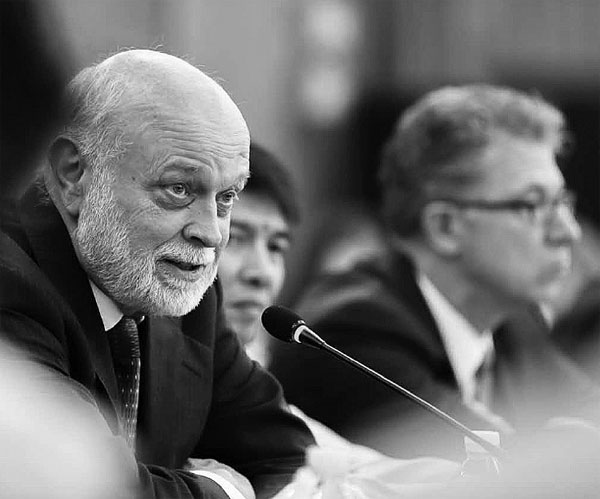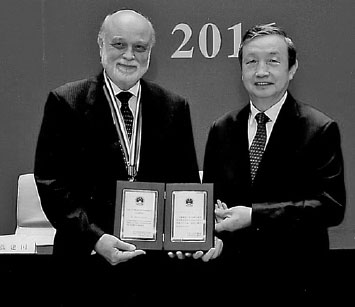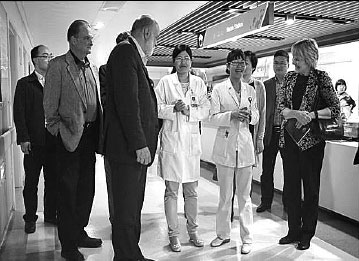Of head and heart
Updated: 2016-10-28 08:20
By Liu Xiangrui(China Daily)
|
|||||||||
Richard Hart from a US nonprofit has invested his time and expertise in a Chinese hospital, Liu Xiangrui reports.
When Richard Hart, an expert in healthcare management from the United States, is asked about his China connection, he starts from the beginning.
Hart, 71, is proud that his organization has been associated with China's health endeavors for more than 100 years. He is the president of Loma Linda University Health, a California-based religious nonprofit that has a number of affiliates such as Loma Linda University and Loma Linda University Medical Center.
The earliest graduates from his university came to work in China in 1914, Hart tells China Daily.
Among them was Harry Miller, who later came to be known as the "China doctor" because he established 10 hospitals in the country and used soy milk to treat malnutrition in children.
Hart's first personal involvement with Chinese healthcare was in the late 1970s as dean of the university's public health school. He came to Beijing several times for a project that was being carried out between his university and the central government's health administration, in a bid to help with nutrition campaigns.
His university carried out more projects in China after that.
In the late 1980s, Run Run Shaw, a well-known businessman and philanthropist from Hong Kong, offered to provide money to the local government of East China's Zhejiang province to build a hospital in Hangzhou, the city where he grew up. Shaw made the decision because his mother had received treatment from Miller years earlier.
"When they came to Loma Linda and asked whether we'd be willing to assist, we agreed," Hart recalls.
Since then, Hart's organization has played an important role in the management and training of staff at Hangzhou's Sir Run Run Shaw Hospital, which finally opened in 1994. It was quickly expanded into a research-oriented general hospital. It was among the country's earliest hospitals to introduce some advanced practices such as minimally invasive surgeries that help patients to heal faster and reduce costs.
As the chairman of the board of this hospital, Hart visits it at least once a year. He holds regular meetings with his university's department that manages its international cooperation programs. The university has actively participated in the nurturing of talent. About 1,000 doctors, nurses, administrators from Loma Linda have visited the Hangzhou hospital over the years.
Around 300 staff members from the hospital have been trained at Loma Linda, too.
"There is a huge exchange of personnel between our two institutions," says Hart.
He even initiated a special hands-on program that allowed physicians from the hospital to work alongside doctors in the US.
Besides introducing clinical skills and best practices, Hart and his university have offered the hospital opportunity to improve its medical care through the sharing of ideas and culture, according to Zhan Yilei, assistant director of the hospital's Center for International Collaboration.
Traditionally a doctor's work is done as long as she or he has treated the disease well. But that's not enough and things like privacy in the wards or follow-up services for patients are important as well, Zhan says.
"Good health is not just a matter of healing infection or doing surgery," says Hart. "It is being comfortable and healthy in all aspects of life - physically and mentally. Our mission is to make a man whole."
"It's probably the greatest legacy Loma Linda has provided to it (the Hangzhou hospital)."
Decades of partnership with Chinese medical institutions has allowed Hart to gain a deep understanding about China's healthcare system. He believes the issue of cost effectiveness is going to be a challenge for China even in the future.
"There are many new hospitals coming up. But the hospitals are very expensive places. It (healthcare system) is going to crash if we don't figure out who is going to pay for that," he says.
He thinks the government will develop a proper health insurance system eventually and figure out how to make medical care more cost-effective and accurate to curb problems including excessive treatment.
Hart, who got his doctor's degree in the 1970s, has had a long career in medical services, management and education, and is still on the go. He has worked in many countries and served different organizations, including as a senior consultant to the World Health Organization.
He says the usual challenges in healthcare systems he has encountered elsewhere are insufficient resources and weak finances.
One of the biggest advantages for Chinese healthcare has been the country's economy, he says. "It's not been so much of a problem here."
"My biggest concern is to give the doctors the support system they need, because doctors can't do it all. For them to be effective, you need a team around them," he adds.
Recognized for his dedication to China's medical development, Hart received the Friendship Award, the highest honor given by Chinese government to foreigners who have made significant contributions to the country's social and economic development, in late September.
According to Hart, his university and the Hangzhou hospital are looking to deepen collaboration in the future, including a plan to jointly start a college of health sciences in China. The new school will look into future needs for disciplines that have yet to be developed in China - nursery specialists and dental hygienists to name a few.
Contact the writer at liuxiangrui@chinadaily.com.cn
|
US healthcare expert Richard Hart has been dedicated to supporting China's healthcare system for decades. Photos Provided To China Daily |
|
Left: He receives the Friendship Award from VicePremier Ma Kai in Beijing in September |
|
Above: Hart visits Sir Run Run Shaw Hospital in Hangzhou. |
(China Daily 10/28/2016 page20)
Today's Top News
Party ramps up supervision
Queen Elizabeth visits new town Poundbury
UK retailers catering for homesick Chinese
UK government opts for new Heathrow runway
China's business leaders optimistic about UK
Workers tear down Calais 'Jungle'
UK university heads Chinese pregnancy research
Chinese hostages freed by pirates are heading home
Hot Topics
Lunar probe , China growth forecasts, Emission rules get tougher, China seen through 'colored lens', International board,
Editor's Picks

|

|

|

|

|

|










